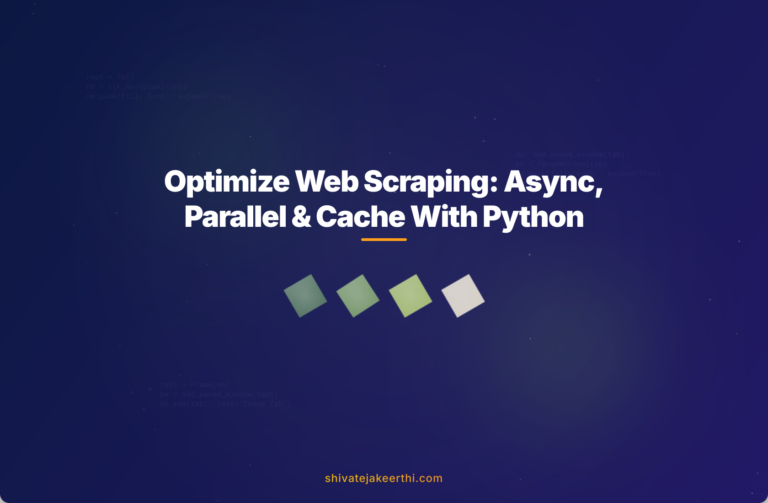Web scraping has become a valuable skill in data collection, analytics, and decision-making. Whether you’re extracting product prices, news content, or sports statistics, scraping information from websites provides immediate, actionable data. However, websites with large data tables pose significant challenges, requiring thoughtful approaches to optimize performance and efficiency. Recently, while scraping data from a website with over 20,000 pages and around 15 rows per page, I encountered substantial inefficiencies. Let me share the challenges faced, initial approaches, and the effective optimization strategies applied for seamless and efficient web scraping.
Initial Attempts and Challenges in Scraping
When I first tackled this task, I naturally turned to Python’s powerful BeautifulSoup and Requests libraries. The initial script aimed to fetch each web page individually and extract data using basic Python code. Here’s an example snippet illustrating the basic scraping approach:
import requests
from bs4 import BeautifulSoup
url_template = "https://example.com/data/page={}"
all_data = []
for i in range(1, 20001):
response = requests.get(url_template.format(i))
soup = BeautifulSoup(response.text, 'html.parser')
for row in soup.select('table.large-data-table tr'):
cells = row.find_all('td')
if cells:
row_data = [cell.text.strip() for cell in cells]
all_data.append(row_data)
print(f"Scraped page {i}")
While this approach worked fine at a smaller scale, it quickly became clear that it wasn’t going to be efficient enough for 20,000 pages. Each page took roughly one to two seconds to process, and sequential scraping meant it would take far too long to extract the complete dataset.
Analyzing network requests, I realized the site’s data wasn’t accessible via an external API or through AJAX (XHR), eliminating some standard alternatives. Therefore, optimizing the existing scraping method became essential.
The Need for Optimization
Think about having to load and unload moving boxes from a truck, one box at a time. It would be far quicker if several people unloaded boxes simultaneously or if boxes could appear quickly and in parallel. Similarly, web scraping large tables becomes significantly faster with parallel processes and efficient resource utilization.
With over 20,000 pages, each containing around 15 rows, we’re looking at roughly 300,000 data points or more. Optimizing scraping methods becomes critical to complete the data extraction in a reasonable timeframe.
Asynchronous Requests: Scraping Without Waiting
Asynchronous scraping refers to sending multiple web requests concurrently, allowing your code to handle multiple requests simultaneously rather than sequentially. Using Python’s aiohttp library makes this quite easy. Here’s a quick look at how asynchronous scraping can be implemented:
import aiohttp
import asyncio
from bs4 import BeautifulSoup
url_template = "https://example.com/data/page={}"
async def fetch(session, url):
async with session.get(url) as response:
return await response.text()
async def scrape_page(session, page_num):
html = await fetch(session, url_template.format(page_num))
soup = BeautifulSoup(html, 'html.parser')
page_data = []
for row in soup.select('table.large-data-table tr'):
cells = row.find_all('td')
if cells:
row_data = [cell.text.strip() for cell in cells]
page_data.append(row_data)
return page_data
async def main():
results = []
async with aiohttp.ClientSession() as session:
tasks = [scrape_page(session, i) for i in range(1, 20001)]
for future in asyncio.as_completed(tasks):
page_result = await future
results.extend(page_result)
print(f"Total scraped rows: {len(results)}")
asyncio.run(main())
Adopting asynchronous requests reduces wait times dramatically, increasing scraping speed by several orders compared to the synchronous approach.
Parallel Processing: The Power of Multiple Workers
Parallel processing is another robust technique to speed up scraping by dividing tasks between multiple processes or threads. Python provides several powerful libraries to accomplish this, including the built-in multiprocessing module or third-party libraries such as Joblib.
For instance, using multiprocessing, you can distribute the scraping workload across multiple CPU cores:
from multiprocessing import Pool, cpu_count
import requests
from bs4 import BeautifulSoup
url_template = "https://example.com/data/page={}"
def scrape(page_num):
response = requests.get(url_template.format(page_num))
soup = BeautifulSoup(response.text, 'html.parser')
page_data = []
for row in soup.select('table.large-data-table tr'):
cells = row.find_all('td')
if cells:
row_data = [cell.text.strip() for cell in cells]
page_data.append(row_data)
return page_data
if __name__ == '__main__':
with Pool(cpu_count()) as pool:
data = pool.map(scrape, range(1, 20001))
all_data = [item for sublist in data for item in sublist]
print(f"Scraped total rows: {len(all_data)}")
The above approach substantially reduces scraping duration by distributing the workload, making it ideal for large-scale web scraping tasks.
Efficient Data Caching: Don’t Fetch Twice!
Repeatedly requesting the same page wastes resources and increases risk of blocks from website servers. Implementing common caching strategies such as storing fetched HTML responses in databases or file systems can prevent redundant requests. Simple caching methods with Python’s lightweight caching library, requests-cache, can solve this effectively:
import requests_cache
requests_cache.install_cache('web_scrape_cache', backend='sqlite')
# All your requests are automatically cached now.
By caching content, your scraping tool fetches only necessary data, clearing significant performance bottlenecks and reducing unnecessary server load.
Refining Code Structure: Cleaner and Faster Scripts
Effective optimization also includes practical code optimization. Avoiding unnecessary loops, using lightweight HTML-parsing approaches, and storing intermediate results efficiently improves runtime performance.
Consider the following tips:
- Minimize repetitive parsing operations
- Use faster parsing libraries like lxml whenever possible
- Store results incrementally to prevent memory overload
For instance, switching to the faster lxml parser with BeautifulSoup is simple:
soup = BeautifulSoup(response.text, 'lxml')
Perform regular benchmarking using Python’s built-in or third-party tools like timeit to identify bottlenecks and measure improvements empirically.
Summing Up Web Scraping Optimizations: Faster Results and Better Data
Scraping large tables poses various real-world challenges: slow retrievals, blocking risks, and resource-intensive execution. Through adopting well-structured asynchronous requests, parallel processing, efficient caching, and smart code optimization, you can efficiently extract massive data tables at substantially faster speeds.
Optimizing scraping procedures enhances productivity, delivers data quicker, and reduces server load, ensuring better, more reliable outcomes in data-intensive scenarios. Curious about other ways to optimize Python scripts or have your own scraping strategies? Share your thoughts or check out additional resources for Python techniques and insights.



0 Comments